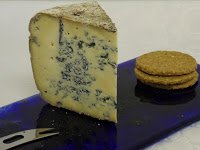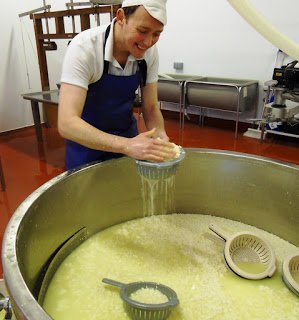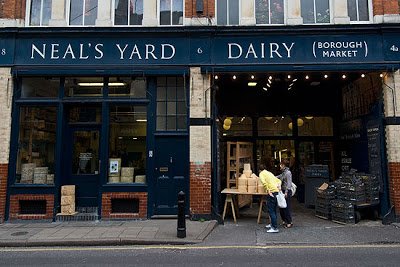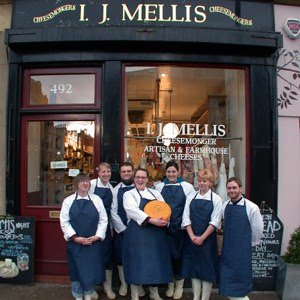It's not just whales
that need saving. Certain cheeses are on the brink of extinction and
risk being lost forever if we aren't careful. That was the premise of
Neal's Yard's Endangered Cheese Traditions event last month, which
was billed as a cheese tasting, but was also a lesson in how
cultural, economic and social changes are threatening to wipe out
some traditional cheeses. There was even a discussion about
transhumant lifestyles.
Don't worry, I had no
idea what a transhumant lifestyle was either until our host Andrew
Nielsen explained it to us (more on that later). Nielsen is a great
bear of an Australian, who gave up a career in advertising several
years ago to become a student of the 'fermentative arts'.
He first became a
cheesemonger at Neal's Yard, before moving to Burgundy to set up his
own vineyard called
Le Grappin. He's also an amateur brewer and
dabbler in cider. “Anything a little bit funky,” is how he put
it.
Nielsen picked a good
company at the start of his 'funky' odyssey. Neal's Yard Dairy is one
of Britain's great cheesemongers, specialising in British and Irish
cheeses and working closely with small farmhouse producers. Set up by
Randolph Hodgson in 1979, the company has two shops, one in Covent
Garden and one in Borough Market.
The Borough shop is
housed in a lovely high-ceilinged, glazed-brick building on the edge of
the market, which long ago was a stables for horses bringing Kentish
hops to the huge breweries that used to line the Thames. The tasting was held upstairs in what would have been the hay
loft.
The cheeses (starting
at 12 o'clock on the plate) were:
Cotherstone - a
pasteurised cows' milk cheese made by Joan Cross in County Durham
Sparkenhoe Red
Leicester - an unpasteurised cow's milk made by David and Jo Clarke
near Upton in Leicestershire
Abbaye de Tamie -
made in the Haute Savoie, France, with unpasteurised cows' milk and
matured by Herve Mons.
Beaufort d'Alpage -
an unpasteurised cow's milk made by Robert Peret in the Haut Savoie
Salers du Burons - an
unpasteurised cows' milk cheese made by Marcel Paille in the
Auvergne, France
Pecorino di Fossa -
an unpasteurised ewes' milk cheese made by Walter Facchini in Umbria
Bleu de Termignon -
made by Catherine Richard in the Haut Savoie from unpasteurised cows'
milk
Stichelton - Made by
Joe Schneider at the Welbeck Estate in Nottinghamshire to a Stilton
recipe, but using unpasteurised milk (so it's not allowed to be
called Stilton.
The lethal drinks
combo, from left to right, was: Saison Dupont Belgian beer, Asturian
Llagar Herminio cider, Arenae Malvasia de Colares wine from Portugal,
and Kernel Brewery porter.
All the cheeses and the
drinks are on the brink of extinction with just a handful of
producers still making them. You might argue that there are loads of
companies making Red Leicester in the UK, but Nielsen's definition of
a 'real' cheese is one made in a traditional farmhouse way (eg, by
small producers with their own herd using raw milk). Taking that
definition, real Red Leicester actually became extinct during the
second world war when farms were forced to sell their milk to the
government and large-scale factory production took over. That was
until it was revived in 1995 when Sparkenhoe was set up.

Other cheeses are on
the edge because they are such hard work to make. The Salers du
Burons requires the cheesemaker to live high in the
mountain for months on end as the cows move further up the slopes. This is the transhumant
lifetsyle, I mentioned earlier, but people just don't want to live
that way any more. “If you're an 18 year old French boy, you want
to be going to discos, not living up a
mountain with a load of cows,” said Nielsen.
The cheese itself was
full-on with an earthy almost musky flavour. You could see why it has
waned in popularity as tastes have changed. As the chap next to me
said, “You have to wonder whether this one really is worth saving.”
The Pecorino de Fossa
is struggling for similar reasons. It had a lot of meaty flavours
going on and quite an acidic bite. The cheese has been made up in
the hills around Umbria for centuries where it is covered in herbs
and buried it in hay for several months. It's such back-breaking,
labour intensive work that there are only two producers left.

Some of this might
sound a bit worthy, but the evening was actually great fun mainly
because Nielsen was such a knowledgeable and entertaining speaker.
For most of the night he was a blur of energy, scribbling on flip
charts and holding up photos, only stopping to take a few sips of
beer. Like all true curd nerds, he got particularly excited explaining
the science of coagulation (look at the love in this
picture).
The next morning, I tried to work out
which cheeses I would personally fight to save. The world would be a
poorer place without Cotherstone, Sparkenhoe and
Stichelton. I also liked the Beaufort and Abbaye de Tamie (which is
very similar to Reblochon), but I could definitely live without the
Pecorino, Salers and Bleu de Termignon. They were just too 'funky'
for me. Sometimes cheeses go to the great monger in the sky for a
good reason.
Endangered Cheese
Traditions is one of many different
tastings run by Neal's Yard. They all last about two hours
and cost £50.
 Their best cheese (in
the Cheese Chap’s humble opinion) is Wrekin Blue. It’s quite
spicy with mineral notes, but it’s all wrapped up in a big blanket
of creaminess.
Their best cheese (in
the Cheese Chap’s humble opinion) is Wrekin Blue. It’s quite
spicy with mineral notes, but it’s all wrapped up in a big blanket
of creaminess. 






